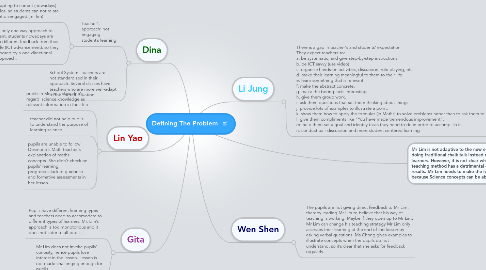Defining The Problem
Door kucing kecil

1. Gita
1.1. Pupils have different learning types and teachers need to accomodate to different types of learners. Mr. Lim’s approach is too monotonous and it does not cater to all pupils.
1.2. Mr Lim does not invoke pupils’ curiosity, hence pupils lose interest in the lesson. Lesson is not made challenging enough for pupils.
2. Lin Yao
2.1. pupils in Mr.Lim's class don't regard science knowledge as relevant information in their life
2.2. teacher did not help pupils to understand the purpose of learning science
2.3. pupils are unable to follow Desmond's Math teacher's explanation of maths concepts. She didn't check on pupils' learning progresses;lack of guidance and formative assessments in her lesson.
3. Dina
3.1. Teacher’s approach: not engaging student’s learning
3.1.1. not adapting to current (nowadays) scenarios. so students can not relate and get disengaged (mr lim)
3.1.2. Mr Lim has only one way approach to teach student. students nowadays are exposed to different feedback from their everyday life (ICT advancement). so they are ea sily bored by a one-directional teaching approach.
3.2. School System: Teachers are not standardized in their approach. Several classes have teachers who are more well-adapt to the current situation.
4. Mr Lim is not adaptive to the new education landscape, doing traditional chalk talk instead of engaging the learners. However, it is not clear whether Mr Lim’s teaching method has a detrimental effect on their results. Mr Lim needs to make the lesson relevant because Science concepts can be abstract.
5. Li Jung
5.1. There is a gap in teacher's and students' expectation: They expect teachers to: a. be systematic, and give step-by-step instructions b. be ICT savvy (use video) c. organise hands-on activities, discussion, role playing, etc. d. make their learning meaningful to them to their life. e. learn something that is relevant f. make the abstract concrete. g. make the boring facts interesting. h. give them group work. i. ask them questions that set them thinking about things. j. provide lots of examples to illustrate a point. k. show them how to apply the formulas (in Maths) to solve problems rather than to ask them to memorise by hard. l. give them compliments like “You have made tremendous improvement”. m. help them set a goal and identify tasks they need to do in order to accomplish it. n. conduct pair discussion and more student centered learning
6. Wen Shen
6.1. The pupils are not giving direct feedback to Mr Lim, thereby leading Mr Lim to believe that his way of teaching is working. Maybe if they open up to Mr Lim, Mr Lim can change his teaching strategy Mr Lim only assesses their learning at the end of the lesson by asking verbal questions. Ms Chong gives examples to illustrate concepts when the pupils do not understand, so it’s clear that she asks for feedback regularly.


